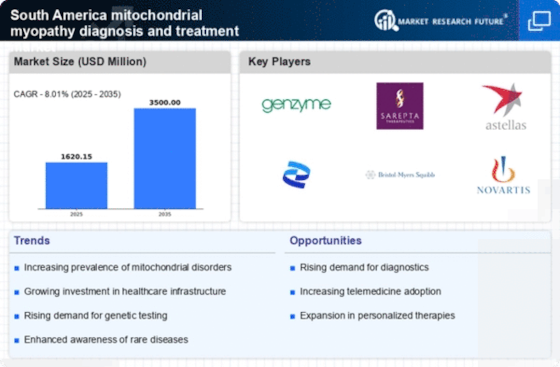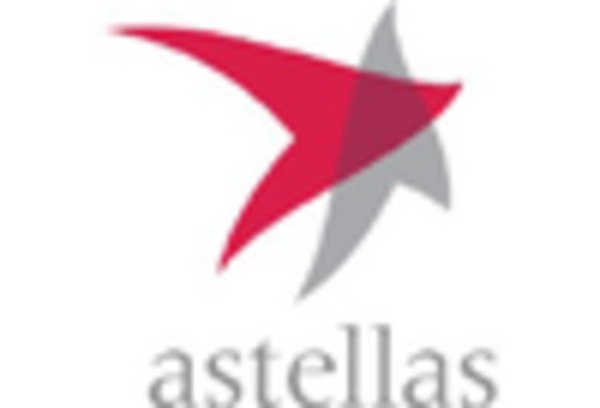Government Initiatives and Funding
Government initiatives aimed at improving healthcare infrastructure in South America are driving the mitochondrial myopathy-diagnosis-treatment market. Increased funding for rare disease research and the establishment of national health programs are pivotal in enhancing diagnostic capabilities and treatment accessibility. For instance, several South American countries have allocated substantial budgets to support research on mitochondrial disorders, which is expected to yield new therapeutic options. Additionally, public health campaigns aimed at raising awareness about mitochondrial diseases are likely to lead to earlier diagnoses and better patient management. These initiatives not only foster collaboration between public and private sectors but also encourage the development of innovative solutions within the mitochondrial myopathy-diagnosis-treatment market, ultimately benefiting patients and healthcare providers alike.
Growing Patient Advocacy and Support Groups
The emergence of patient advocacy and support groups in South America plays a vital role in the mitochondrial myopathy-diagnosis-treatment market. These organizations are instrumental in raising awareness about mitochondrial disorders, providing resources for patients and families, and advocating for better healthcare policies. By fostering a community of support, these groups empower patients to seek timely diagnoses and appropriate treatments. Their efforts often lead to increased funding for research and development, as well as improved access to clinical trials. The influence of patient advocacy groups can also drive pharmaceutical companies to invest in the development of new therapies, thereby expanding the treatment landscape for mitochondrial myopathy. This growing network of support is likely to enhance the overall market dynamics, creating a more favorable environment for innovation and patient care.
Advancements in Genetic Testing Technologies
Technological innovations in genetic testing are significantly impacting the mitochondrial myopathy-diagnosis-treatment market in South America. The introduction of next-generation sequencing (NGS) has revolutionized the ability to diagnose mitochondrial disorders with greater accuracy and speed. This advancement allows for the identification of specific genetic mutations associated with mitochondrial myopathy, facilitating personalized treatment approaches. As the cost of genetic testing continues to decrease, more patients are likely to access these services, thereby expanding the market. Furthermore, the integration of genetic counseling into clinical practice enhances patient understanding and management of their conditions. The growing reliance on genetic testing underscores its pivotal role in shaping the future of the mitochondrial myopathy-diagnosis-treatment market, as it aligns with the broader trend towards precision medicine.
Emerging Therapeutic Options and Clinical Trials
The ongoing research and development of new therapeutic options for mitochondrial myopathy are significantly influencing the market in South America. Numerous clinical trials are currently underway, exploring various treatment modalities, including gene therapy and mitochondrial replacement techniques. These emerging therapies hold the potential to address the underlying causes of mitochondrial disorders, rather than merely managing symptoms. As clinical trial results become available, they are expected to reshape treatment paradigms and expand the available options for patients. The increasing participation of South American institutions in international research collaborations further enhances the region's role in the global landscape of mitochondrial myopathy-diagnosis-treatment market. This focus on innovative therapies not only promises to improve patient outcomes but also stimulates market growth by attracting investment and interest from pharmaceutical companies.
Increasing Prevalence of Mitochondrial Disorders
The rising incidence of mitochondrial disorders in South America is a crucial driver for the mitochondrial myopathy-diagnosis-treatment market. Recent studies indicate that mitochondrial myopathy affects approximately 1 in 5,000 individuals in the region, leading to a growing demand for effective diagnostic and therapeutic solutions. As awareness of these disorders increases, healthcare providers are more likely to seek advanced diagnostic tools and treatment options. This trend is further supported by the establishment of specialized clinics and research institutions focused on mitochondrial diseases, which enhances the overall landscape of the mitochondrial myopathy-diagnosis-treatment market. The increasing prevalence not only highlights the need for better healthcare resources but also encourages investment in research and development, potentially leading to innovative therapies and improved patient outcomes.

















Leave a Comment